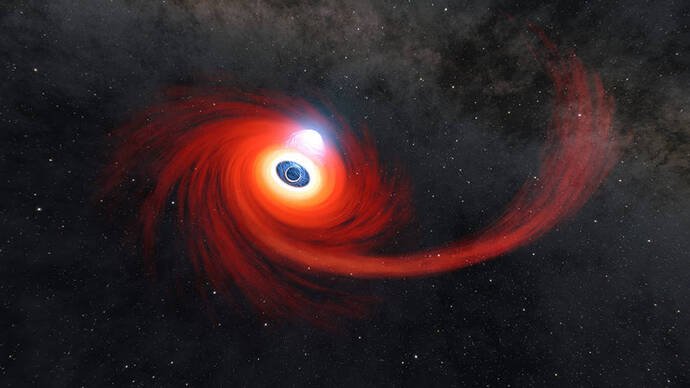The Bizarre Behavior of Black Holes
Researchers at Caltech study all manner of odd black hole behaviors. In honor of Black Hole Week, here are a few of them, from gobbling up stars to dancing and chirping.
by Whitney Clavin
Black holes are strewn across the universe, from our own galaxy to the farthest reaches of the cosmos. Made of matter so dense that it twists the fabric of space and time, these dark beasts are called black because even light cannot escape the grasp of their gravity. Some contain just a few times the mass of our sun, though the behemoths at the centers of galaxies can hold up to tens of billions of times more mass than our star. Black holes can, at times, lie dormant and unmoving like sea urchins in a cosmic ocean, but they can also be ferocious eaters.
Ripped to Shreds
When stars wander too close, black holes can shred them to pieces. Called tidal disruption events, or TDEs, these cosmic cataclysms happen when the gravitational pull of a black hole rips apart the doomed star and creates a glow of light telescopes can detect.
In 2021 and 2022, several telescopes—including the Caltech-led Zwicky Transient Facility (ZTF) operating from Palomar Observatory and the Caltech-led NuSTAR (Nuclear Spectroscopic Telescope Array)— saw a TDE in a galaxy 250 million light-years from Earth, one of the closest TDE encounters seen to date.
A Cosmic Chirp
Many black holes are found in pairs that orbit each other like ice dancers. Eventually they collide, merge, and coalesce into one giant body. The National Science Foundation-funded LIGO (Laser Interferometer Gravitational-wave Observatory) detects ripples in space and time called gravitational waves that emanate from pairs of merging stellar-mass black holes. When researchers translate the gravitational waves into sound waves and shift up the frequency to better suit human ears, they hear a distinct “chirp.” Compare the chirps from different black hole mergers here.
Flash in the Dark
Some scientists think that colliding black holes might also emanate flashes of light waves, but only when the black holes in question are embedded in thick disks swirling around a more massive black hole. On May 21, 2019, LIGO and partner observatory Virgo detected gravitational waves from a pair of merging, jiggling black holes, while, around the same time, ZTF caught a flare of optical light from the same location. The scientists speculate that the two events could be correlated and have since found other similar scenarios. They think that two smaller merging black holes are plowing through gas surrounding a much more massive one, creating the brilliant flares.
When Titans Collide
Even the supermassive black holes that lie in the hearts of galaxies can spiral around each other and merge. In one Caltech-led study that analyzed 45 years of radio observations, astronomers found direct evidence of two supermassive black holes locked in a two-year dance at the heart of a galaxy 9 billion light-years away.
Camera Ready
A couple of black holes have reached celebrity status. With the help of radio telescopes across the globe and some clever image processing, the Event Horizon Telescope (EHT) project took the first photograph of the supermassive black hole at the center of a galaxy called Messier 87 in 2019. The photograph shows not the black hole itself, but the shadow it cast on a ring of glowing material that encircles it. In 2022, EHT took the first-ever picture of the black hole lying at the heart of our own galaxy, called Sagittarius *A (seen below). This black hole is much less massive than M87’s, and material is swirling around it at a faster rate, making it even harder to image.




